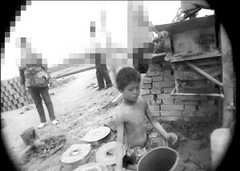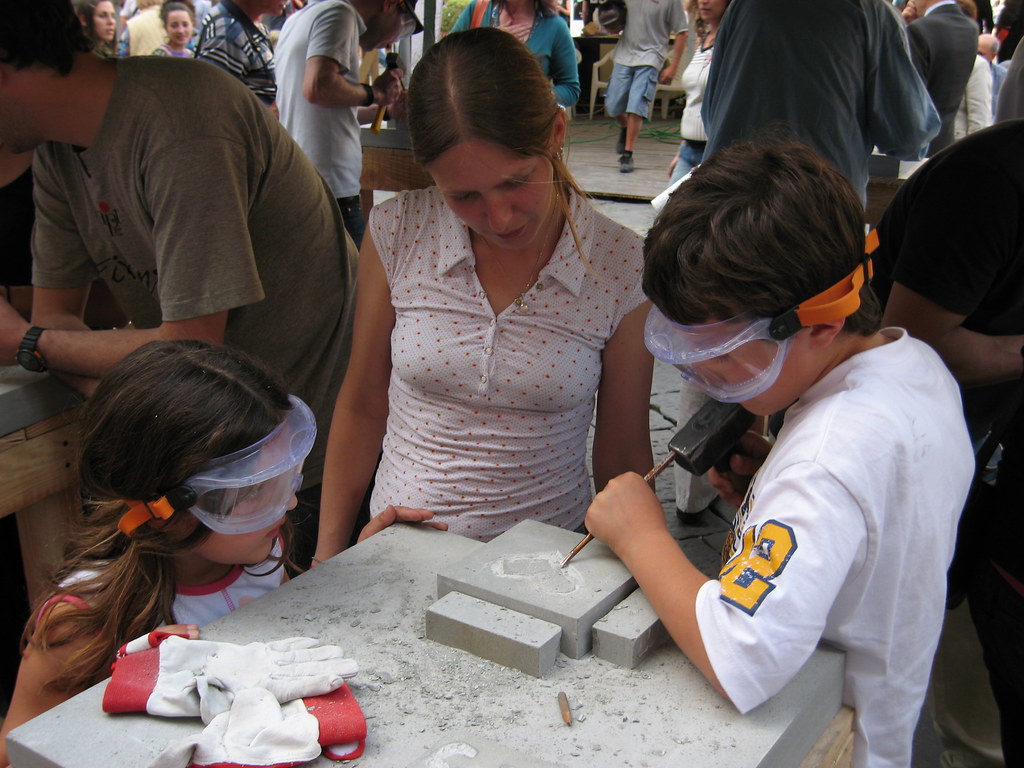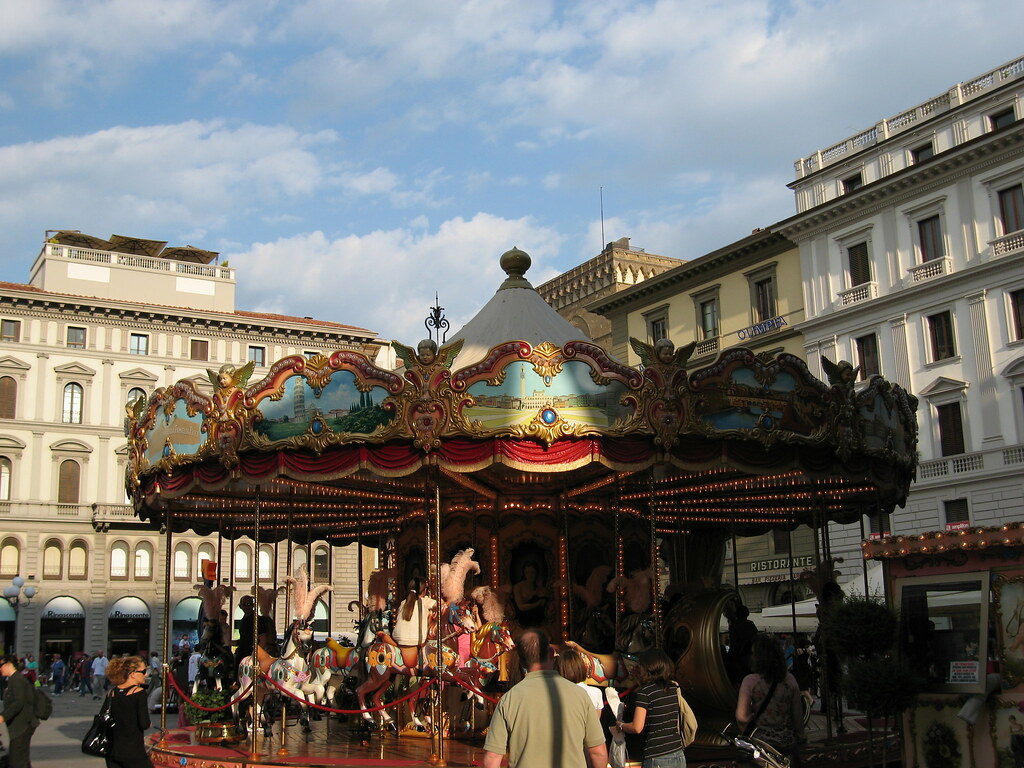今日雨果
hugodemain@yahoo.fr 博客名 “今日雨果”純為召喚維克多·雨果代表的一種崇高精神。我名叫“小雨”。歌劇《磚窯孩子》
Opéra “Les Enfants des Briqueteries”
Opera “Bambini in Borno”
Opera “Children in Kiln”
作者: 今日雨果


(取自,謝謝)
意大利,佛羅倫薩,歐洲文藝複興發源地,市中心廣場上,孩子們正聚精會神地在磚上雕刻愛心。小雨攝於2007年5月
意大利,佛羅倫薩,市中心,位於同一個廣場上,供兒童們遊玩的旋轉木馬。小雨攝於2007年5月
歌劇《磚窯孩子》
序曲
第一場
(童聲獨唱)爸爸啊爸爸,小豆子很想你。
這裏的磚太多太沉。
我好想摟著你的腰騎上自行車,
我好想拉著你的手走進小學校。
媽媽啊媽媽,小豆子很想你。
這裏的泥太濕太冷。
我好想穿你縫補的舊衣服,
我好想吃你做的熱菜熱湯。
(男女聲二重唱)孩子啊孩子,你在哪裏?
你的爸爸媽媽在想你。
不要流淚,不要哭泣,
黑暗就會過去,光明就要來臨。
(童聲獨唱)星星啊星星,請你不停地眨眼睛,
為小豆子指引方向。
月亮啊月亮,請你快快鑽出雲朵,
為小豆子點一盞明燈。
(男女聲二重唱)孩子啊孩子,你在哪裏?
你的爸爸媽媽在找你。
不要難過,不要傷心,
冬天已經過去,春天已經來臨。
小鳥啊小鳥,請你快快醒來歌唱,
教育我們的孩子鼓起勇氣。
太陽啊太陽,請你快快升起,
為我們的孩子帶去溫暖和光明。
(合唱)孩子啊孩子,我們看見了你,
你的親人們會幫你。
擦去眼淚,看清世界,
把妖魔趕下地獄,把鬼怪押上法庭。
孩子啊孩子,我們看見了你,
全世界的叔叔阿姨們會關心你。
抬起頭,挺起胸,
你一定是個好孩子,你一定會成個好藝術家。
第二場
在一群神秘的好心人的幫助下,小豆子與父母重逢。。。
(童聲獨唱,男女聲二重唱,童聲及男女聲三重唱)
。。。
在一群神秘的好心人的幫助下,小豆子回到了學校。每天唱著歌去上學。
“杏花村裏來了一群小鴨子”
(童聲獨唱,男女童聲二重唱,童聲合唱,少年芭蕾伴舞)
杏花村裏養了一群小鴨子
我天天早晨趕著它們到池塘裏
小鴨子向著我嘎嘎嘎地叫
再見吧,小鴨子
我要上學了
再見吧,小鴨子
我要上學了
杏花村裏養了一群小鴨子
我放學回來趕著它們到棚裏去
小鴨子向著我嘎嘎嘎地叫
睡覺吧,小鴨子
太陽下山了
睡覺吧,小鴨子
太陽下山了
在美術老師的精心培育下,小豆子(肖青鬆)愛上了泥塑藝術。。。
(童聲獨唱,童聲合唱)
第三場
1989年,天安門,民主運動,肖青鬆雕塑《民主女神》,而遭追捕。。。
在一群神秘的好心人的幫助下,他乘小船背井離鄉,飛奔自由。。。(可引鑒羅西尼歌劇《Tancredi》 "Di tanti palpiti"中乘船的情景及八位歌唱家對該詠歎調不同的演唱風格[5])
肖青鬆出國後,觀看到《巴赫-為自由而戰》[6]這部影片,觸景生情,禁不住淚如雨下。他為那位夢想成為石雕匠的小男孩遇到了巴赫良師的幸運而感到羨慕,他為自己那惡夢般不堪回首的遭遇而感到悲傷,他在思想上有了質的飛躍。。。(男高音大段詠歎調獨唱)
“在激情中生活!”從此,他更迷上了雕塑藝術。。。
(合唱)
。。。
第四場
肖青鬆艱苦求索,訪問、研究了世界各國多姿多彩的雕塑藝術。。。(此處,可引鑒小約翰·施特勞斯的歌劇《蝙蝠(Die Fledermaus )》中如何穿插舞蹈場麵,從而以各國舞蹈、芭蕾,展現多姿多彩的雕塑藝術)
肖青鬆在創作過程中,遇到了知音,愛上了一位女芭蕾演員。。。(此處,可引鑒小約翰·施特勞斯的歌劇《蝙蝠(Die Fledermaus )》中,帕瓦洛帝演唱的牧羊人對戀人的思念之歌,以及帕瓦洛帝與瓊·薩瑟蘭的深情二重唱[7])
他激發出無窮無盡的創作靈感,作品層出不窮,成了一名二十一世紀出色的雕塑家。
。。。
第五場
盛名之下,肖青鬆仍念念不忘當年助他脫離苦海的好心人,到處去找她(他)們。。。
(男高音獨唱,男女聲二重唱,男女多聲部重唱,大合唱)
。。。
後記
Post-scriptum
Poscritto
Postscript
同樣是發生在2007年5月,同樣是一個地球上的少年兒童,同樣是麵對著一塊塊磚,他們的境遇竟是如此的天壤之別。
說真的,實在不忍心把這兩組照片放在一起,唉。。。
上方兩張照片[1][2]:發生在2007年5月,中央電視台《時空連線》報道,山西黑磚窯裏的孩子。孩子反應遲鈍,常常語無倫次。但被記者問及磚窯時,孩子嘴裏蹦出了“監獄”的字眼。
下方兩張照片:也是發生在2007年5月,意大利佛羅倫薩[3](位於意大利中部,14世紀~16世紀歐洲“文藝複興”[4] 的發源地。有一說是,徐誌摩把它譯成“翡冷翠”,更富有詩意)。小雨隨意逛到該市中心的一個廣場上,遠遠地就聽到歡聲笑語不斷,走近才知是當地某組織在向少年兒童免費傳授“文藝複興”時期的雕刻技術。照片前景上的孩子正聚精會神地在磚上雕刻一顆愛心,您可看到左側和後方的孩子們也在雕刻,旁邊還有雕刻師專門指導。一共有五六個雕刻工作台,其他台上雕刻的形象更複雜,記得有一個形象是兒童的頭像。
小雨人在天涯,天隔一方,全然不知山西黑磚窯童工之苦,深深歎惜當時隻拍了這一張。。。
參考文獻
Référence
Riferimento
Reference
[1]
山西黑磚窯379人獲救童工自述猶如監獄服刑
http://www.syd.com.cn/2007-06/15/content_24044605.htm
[2]
往事不堪回首:大學生講述淪為黑窯奴工的親身經曆
文章來源: 瀟湘晨報於 2007-06-19
http://news.wenxuecity.com/BBSView.php?SubID=news&MsgID=419222
[3]
佛羅倫薩
維基百科,自由的百科全書
http://zh.wikipedia.org/wiki/佛羅倫薩
[4]
文藝複興
維基百科,自由的百科全書
http://zh.wikipedia.org/wiki/文藝複興
[5]
Gioachino Rossini - Tancredi - "Di tanti palpiti" (Marilyn Horne, Lucia Valentini-Terrani & Agnes Baltsa)
http://www.youtube.com/watch?v=7KWS7Zd8GJ4
Gioachino Rossini - Tancredi - "Di tanti palpiti" (Ewa Podles, Vesselina Kasarova & Jennifer Larmore)
http://www.youtube.com/watch?v=42zVcZEbsjI
Gioachino Rossini - Tancredi - "Di tanti palpiti" (Cecilia Bartoli & Vesselina Kasarova) - Appendix
http://www.youtube.com/watch?v=Q9P6VI46I_o
Not one compilation of Rossini's musical output would be complete without his first "hit tune": "Di tanti palpiti", the moderato section (a cabaletta of sorts) from the cavatina of Tancredi. In his biography of the Maestro, Stendhal wrote that the aria of Tancredi, known throughout Europe, was the most popular opera aria of its time... And also refered to as the "rice aria" because Rossini is supposed to have composed it while waiting for his risotto to cook one day in Venice (imagine: a hungry composer composing such a little masterpiece out of boredom :) )!
The cavatina deals with Tancredi's return from exile Tancredi to defend his homeland against the Saracene besiegers (and to see Amenaide, of course).
Although many recordings of the aria usually give us only the moderato, Tancredi's cavatina is actually a whole scene: an interlude (depicting Tancredi's boat dropping anchor in a port) - an impassioned recitative - a short (and rather boring) aria - a "cabaletta". It's also interesting to point out that the aria is quite "unrossinian" in character, it almost seems to come from another musical period: the moderato section could be attributed to any composer from the end of the 18th century.
I decided to post only the "Di tanti palpiti" section for a number of reasons, chief amongst them being the fact that it is really the best part of Tancredi's cavatina. It's almost a suprise when it appears after the rather uninspired cantabile.
I once had about ten versions of this aria (including two renditions sung by sopranists, Kowalsi and Manzotti) but I narrowed the choice to six versions:
1) Marilyn Horne (I presume that it's from her full recording of the score). A real classic, Horne just continues to pour out beautiful sound during the whole piece. I also the use of moderate ornamentation during the repeat which doesn't destroy the musical balance and the slow, relaxed tempo from the orchestra.
2) Lucia Valentini-Terrani (from her disk "Arie di Rossini" with Zedda). A good rendition but I find the voice a bit too light for the role. The additional coloratura is well integrated but a bit over the top in places (listen to the very beginning of the repeat, it's a bit too extroverted for a warrior returning to an "ungrateful homeland").
3) Agnes Baltsa (from "Agnes Baltsa sings Rossini" with Marin). Baltsa really "gets" the situation and offers some relaxed singing though I don't like the intrusive mannerisms (there some unattractive glottal attacks). Marin seems to want to mute out the singer with a very loud orchestra.
4) Ewa Podles (from the complete recording with Zedda). I personally love the relaxed conducting here: no rushing. I also think that Podles comes close to Horne's standard. An excellent account.
5) Vesselina Kasarova (from the complete recording with Abbado). Again, as in the selections of the second act duet for the lovers, I find that Kasarova is somehow over the top: she paints almost every word and adds quite a lot of ornamentation, even to the first verse (though, most of it is tasteful; the problem is in quantity, rather than quality). She is good but quite overwhelming.
6) Jennifer Larmore (from her excellent album "Call me Mister"). I really do like Larmore, and she doesn't disappoint here: she really sounds like a warrior (compare with Valentini-Terrani who sounds rather tame by comparison). Ornamentation is good, even if it is familiar (though after listening to six versions of the same aria it is bound to be).
The renditions are grouped into two uploads (just check the title to find the one you would like to hear :)).
I also decided that a little appendix wouldn't hurt, so I am also uploading two replacement arias for "Di tanti palpiti":
7) Cecilia Bartoli (from her hit album "Maria"). The piece presented is actually Giovanni Pacini's own composition, "Dopo tante e tante pene" composed for "Tancredi" to show off Maria Malibran's wide vocal range. It's actually not bad, the cabaletta is even quite fun to listen too but it would seem out of place in Rossini's opera (to my mind it is too romantic for Rossini's more classically composed opera).
8) Vesselina Kasarova (again, from the full recording under Abbado). This aria is very similar to the replacement aria for Lindoro in "L'italiana in Algeri" ("Concedi, amor pietoso"), especially the cabaletta. It is quite good as a replacement because it features a much better cantabile section (a way better one, in fact) and the cabaletta is as passionate as in the original.
Hope you enjoy :)! Do take your time and listen to all selections, it's quite interesting to compare them (though, again, this isn't a contest, rather a comparison).
P.S. If you'd rather hear a countertenor sing the aria, then check David Daniel's excellent account on Youtube :).
[6]
★ 巴赫牧羊隨想曲 2007-10-19 23:10:27
作者:今日雨果
這幾天在觀看 DVD《巴赫 - 為自由而戰》(德語《Bach - Kampf für die Freiheit》法語《Bach - Lutte pour la Liberté》意大利語《 Bach - Lotta per la Libertà》英語《Bach – Fight for Freedom》)的DVD(1995)。影片中,均以巴赫作的樂曲為背景音樂,石雕匠的鑿石節奏,家庭聚會的歡樂笑聲,。。。凡人世間的一切美好景象,都成了他創作的源泉。
影片主要講的是巴赫與一位夢想成為石雕匠的小男孩之間的故事。其中,巴赫找到了一個激動人心的擔任音樂大師的職位,因循守舊的公爵不準他離去。巴赫義正詞嚴地對他說:“我是我自己的主人,你無權將我困在這兒!”公爵將他囚禁在監獄裏,他繼續作曲不已。
在影片中,巴赫對小男孩說:“從不絕望!我知道當無人相信你的時候的感覺是什麽滋味。你隻是要堅持不懈地相信你自己,你要知道你的內心深處是如何的獨特,。。。人類的精神是那麽一種不可思議的力量,。。。盡管有人千方百計要使你感到絕望,我們的精神依舊可以高揚在天上翱翔。。。在激情中生活!”
寫到此處,小雨突然想起了一件事。您一定還記得2007年6月有關“山西黑磚窯孩子”的報道吧。有朝一日,如果您見到了這些磚窯孩子,請一定讓他們觀看《巴赫 - 為自由而戰》這部影片,小雨相信他們一定會以巴赫為良師,以那位夢想成為石雕匠的小男孩為榜樣,從此在激情中成長,在激情中生活。與此同時,歌劇“磚窯孩子”的劇情也就有了新的發展。
http://blog.wenxuecity.com/blogview.php?date=200710&postID=27865
[7]
Luciano Pavarotti and Marilyn Horne as guests of Joan Sutherland in the operetta: The Bat/ Part 1
http://www.youtube.com/watch?v=ciVuD1pWZW8
Luciano Pavarotti and Marilyn Horne as guests of Joan Sutherland in the operetta: The Bat/ Part 2
http://www.youtube.com/watch?v=Y1xDgoce2Eg
原稿 : 2007年6月17日:小詩
二稿 : 2007年6月18日
三稿 : 2007年6月20日:改為唱詩
四稿 : 2007年7月15日:改為歌劇
五稿 : 2007年10月20日:觀看 DVD《巴赫 – 為自由而戰》後,有感而發,修改劇情。
六稿:2010年12月24日:聖誕夜,再次觀看 DVD《巴赫 – 為自由而戰》後,有感而發,劇情由三場增為五場。
七稿:2012年4月1日: 吸收素材:實拍:山西農村兒童簡陋窯洞中艱辛求學(組圖)
最新稿:始終登載於小雨的博客上:http://blog.wenxuecity.com/myindex/13005/
聲明:轉載請務必注明作者及出處。若無注明,所有照片及視頻均為作者所攝。作者保留文字,照片及視頻的版權。
聯係:hugodemain@yahoo.fr




